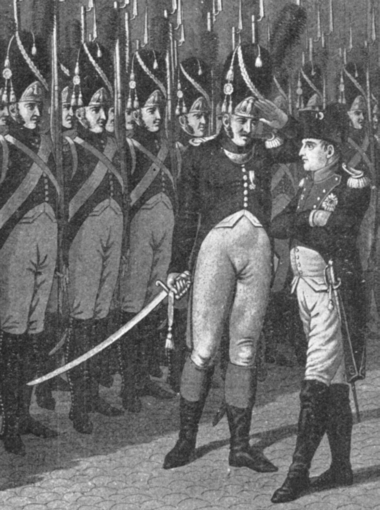|
|
|
|
| auf Deutsch | en français | po polsku |
In 1813, the 3rd edition of the "Manuel d'Infanterie ou Résumé de tous les Règlemens, Décrets, Usages, Renseignemens, propres à cette Arme. Ouvrage renfermant tout ce que doivent savoir les sous-officiers." (Manual of infantry or summary of all regulations, decrees, usages and hints useful for this arm. A work which contains everything that the NCOs must know.) was published in Paris.
Author of this work was Etienne-Alexandre Bardin (1774-1841). He writes (nº 202, pages 198-201, translation by Martin Lancaster):

|
|
Detail from a print by Jügel: "Parade of the Imperial Guard in the Lustgarten in Berlin 1806." |
There is another kind of honours, which we will call internal honours [honneurs intérieurs]. It consists in public testimonies of a hierarchical politeness, and is expressed by salutations of a pre-determined form. The beautiful ordonnances of 1788 have not failed to fix these useful details. Our regulation of police [réglement de police, of June 24th, 1792], which has copied the regulation of July 1st, 1788, has remained silent on the rules of the military civility, but it has not replaced them with nothing. Here is in substance what are these rules:
If general officers [officiers-généraux] or superior officers of the regiment pass near to sergeants, corporals and soldiers, when they are sitting or standing, the former have, in the first case, to get up and take the position of "Portez – vos Armes", the bas-officiers (1) take off their hat, the soldiers raise their hands to it; in the second case they have to face the person saluted.
If subordinates are marching, and they pass in front of their superior who is stationary, the bas-officiers salute by taking off their hat (1), the corporals and soldiers by raising the flat hand to it.
If subordinates are marching, with arms and not in formation, the bas-officier carries his weapon regularly at the right side; the soldier takes the position of "Portez – vos Armes". Both present arms, if they are called by a general officer [officier-général], by the commander of the place [commandant de la place], by a superior officer [officier supérieur] of the regiment, or by the commander of their company.
All corporals and soldiers who are marching without arms, salute general officers [officiers-généraux], superior officers [officiers supérieurs] of their regiment, and the captain [capitaine] of their company by stopping and facing them, without raising the hand to the hat. They salute all the other ranks, by raising, without stopping, the flat hand to the side of the hat opposite to the person saluted.
The bas-officiers (sous-officiers) salute general officers [officiers-généraux], superior officers [officiers supérieurs] and captains [capitaines] of their company, by stopping, taking off their hat, and holding it next to the right side, inclining neither head, nor body. They salute the other ranks in the same manner, but without stopping (1).
If a general officer [officier-général], a superior officer [officier supérieur] or other calls a bas-officier (sous-officier) or soldier, the latter advances with eagerness until he is two or three paces from his superior. He takes the hat off (1), if he is a bas-officier, or raises the hand to it, if he is a soldier, and remains in this position until the officer has ceased to speak.
If superiors are standing and the subordinates pass beside them, the bas-officiers salute by taking off the hat (1), and soldiers by raising the flat hand against it.
Officers salute each other. The superior rank must always render a correct salute to the lower rank.
Officers take off their hats to the bas-officiers (sous-officers) from whom they receive the salute, and raise the hand to it for all soldiers.
When general officers [officiers-généraux], superior officers [officiers supérieurs] or the commander of the company, enter a barrack-room, soldiers rise, take their place at the foot of their bed, and raise the extended hand to the hat until their superior gives them the command "Repos". For any other officer, they rise without changing place.
(1) Note: As the sous-officiers currently wear shakos, like the soldiers, both will raise the hand to the shako, nails in the air, the palm forwards.
In the same book, he writes about the duties of the corporal used as messenger (nº 362, page 365):
A corporal who is a messenger is not allowed to quit his post, nor to put off his cartridge pouch durng this service, as he is on guard duty. As a messenger [ordonnance] he will carry his weapon in the right arm; if he meets officers from the regiment he passes by without stopping, but he will reorder his weapon. A corporal who sends a soldier as a messenger, will assure that the latter will take his musket with him, and that he will carry it in the same manner.
If a corporal or soldier have to carry as messenger a letter or a parcel to a staff officer [officier supérieur] or to a person wo is entitled by the decret concerning the honours to be presented arms, and when they present this letter or parcel to those persons, it is the usage [usage] that they present the weapon with the left hand only, and take and hand over the object of their errand with the right hand. After that they take back the weapon in the right arm, without raising the hand to the shako or bearskin cap.
If they have to carry a letter or parcel to any other person, the military [le militaire] will step forward with the weapon in the right arm, hand over the object of his errand with the left hand, and take the position and the immobility of the NCOs [sous-officiers] under arms, until he gets the answer or a receipt [réçu].